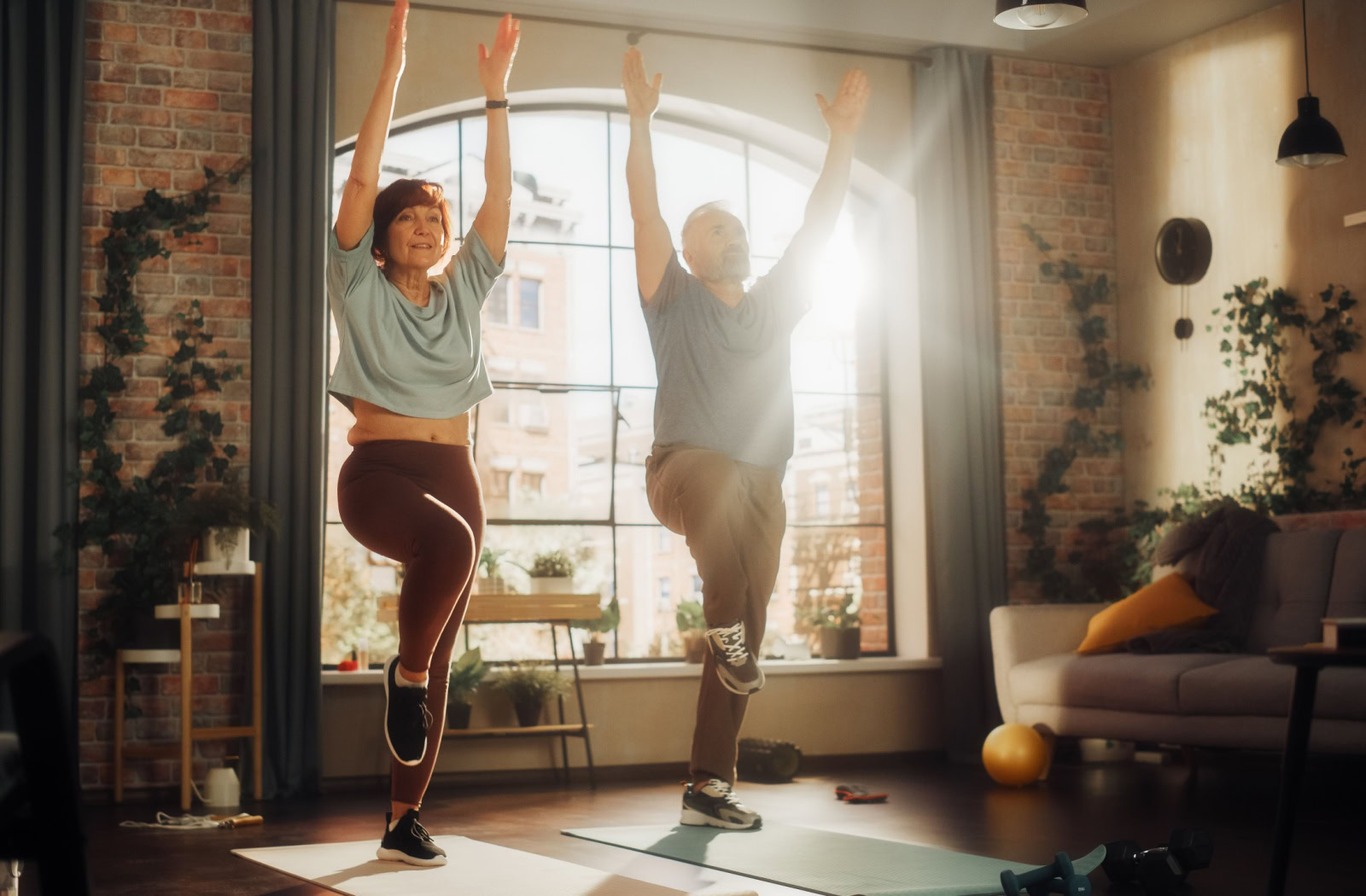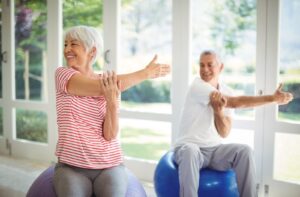Why Should Senior Citizens Perform Balance Exercises?
- Posted on
- By Mira Vie Senior Living

Balance is a crucial part of physical health that many of us take for granted—until we find ourselves less stable on our feet. For seniors, maintaining balance isn’t just about staying upright; it’s about preserving independence, preventing falls, and enhancing overall quality of life—be that at home, in assisted living, or in memory care.
The Importance of Physical Health
Maintaining one’s physical health is the foundation of aging gracefully. Regular movement strengthens muscles, improves joint function, boosts cognitive abilities, and enhances emotional well-being. For seniors, physical activity is even more essential, as it helps combat the natural decline in physical abilities that comes with age.
Balance exercises are vital yet often overlooked aspects of a well-rounded fitness routine. While strength and flexibility help the body stay capable and mobile, balance ensures that everyday activities, like walking or climbing stairs, can be done without fear of falling or injury.
How Aging Affects Balance and Stability
Aging brings about numerous changes in the body, many of which directly impact balance.
- Muscle Loss (Sarcopenia): After age 30, individuals begin to lose muscle mass over time. This can lead to weaker legs, which play a critical role in balance.
- Reduced Bone Density: Bones become more brittle with age, increasing the likelihood of fractures that could further impair mobility.
- Vision Changes: Many seniors experience deteriorating eyesight. Vision is essential for both depth perception and spatial awareness, which are needed to maintain balance.
- Inner Ear Function: The vestibular system in the inner ear, which helps maintain equilibrium, weakens over time.
- Joint Stiffness: Reduced flexibility caused by arthritis or inactivity decreases the body’s ability to recover from a misstep.
These changes make balance exercises essential for maintaining stability and reducing risks associated with aging.
Consequences of Poor Balance in Seniors
Poor balance can have significant ramifications on the physical and emotional well-being of seniors:
- Falls: According to the CDC, falls are the leading cause of injury-related deaths among adults aged 65 and older. One in four seniors falls yearly, and the risk increases with age.
- Fear of Falling: Even without experiencing falls, seniors may develop a persistent fear of falling, which can result in limitations in self-imposed activity and social isolation.
- Cascading Health Problems: Injuries from falls often lead to hospitalizations, reduced mobility, and a decline in overall health.
Balance issues can make daily tasks difficult, creating dependence on caregivers or assistive devices. Encouraging balance exercises is an essential step toward mitigating these risks.
Benefits of Balance Exercises for Physical & Mental Health
Balance exercises provide a wide range of benefits—not only for physical health but also for emotional and cognitive wellness. Here’s how balance exercises can benefit your loved one:
Physical Benefits
- Fall Prevention: Improved stability reduces the risk of falls and serious injuries.
- Stronger Core and Leg Muscles: These key muscle groups are crucial for maintaining posture and stability.
- Better Posture: Improved alignment minimizes strain on the body, preventing pain and improving mobility.
- Enhanced Mobility: Performing balance exercises can make walking, standing up, or climbing stairs easier.
Mental and Emotional Benefits
- Boosted Confidence: Gaining stability can empower your loved one, helping them feel more capable as they go about their daily lives.
- Improved Cognitive Function: Many balance exercises focus on coordination, which engages the brain and supports cognitive health.
- Reduced Anxiety: If your loved one knows they’re less likely to fall, this may ease fear and promote a sense of calm.
Types of Balance Exercises for Seniors
Balance exercises can range from beginner-friendly movements to more advanced routines. Some effective categories include:
- Static Balance Training: Exercises that involve standing still on one leg or trying to hold a position.
- Dynamic Balance Training: Movements that involve shifting weight as part of daily activities, like walking or turning.
- Strength-Based Exercises: These focus on building the muscle groups that support balance, such as the core and lower body.
- Coordination Drills: Catching a ball or moving objects can improve hand-eye coordination and reaction times.
5 Easy Balance Exercises to Get Started
Performing balance exercises can feel intimidating if you haven’t done them in a while. Fortunately, there are easy balance exercises that are safe and effective to get you started.
1. Single Leg Stands
- Stand near a sturdy chair or counter for support.
- Lift one foot off the ground and try to balance on the other foot for 10-15 seconds.
- Repeat on the other leg.
- Perform three sets on each side.
2. Heel-to-Toe Walk
- Walk in a straight line, placing the heel of one foot directly in front of the toes of the other foot.
- Take 15-20 steps.
- Perform 2-3 sets.
3. Seated Leg Lifts
- Sit on a sturdy chair with your back straight.
- Lift one leg off the ground, hold for 5 seconds, then lower your leg.
- Repeat 10 times on each leg.
4. Side Leg Raises
- Stand beside a counter and hold on for support.
- Slowly lift one leg to the side, keeping it straight, then lower it back.
- Repeat 10-12 times on each leg.
5. Marching in Place
- Stand tall and lift each knee as if you’re marching in place.
- Perform for 30 seconds to 1 minute, 3 times.
Tips for Senior Citizens When Performing Balance Exercises
To ensure that your loved one has a safe and enjoyable exercise experience, follow these tips:
- Ensure Safety First: Perform exercises near a counter, wall, or sturdy chair for support.
- Wear Proper Footwear: Choose non-slip, supportive shoes to reduce the risk of slipping.
- Take Breaks: Rest as needed to avoid overexertion or dizziness.
- Warm Up: Always start with basic stretches to prepare the body.
- Check-In Regularly: Ensure movements are performed correctly.
Encouraging balance exercises for seniors boosts their physical strength and fosters a proactive approach to aging.

How Often Should Seniors Do Balance Exercises?
For optimal results, your loved one should aim to perform balance exercises 3 to 4 times per week. Each session can last 20-30 minutes, depending on their fitness levels and endurance. Starting slow is key—consistency is more important than intensity for beginners.
Mira Vie Senior Living knows that incorporating balance exercises into a routine can be a simple but powerful way to improve your loved one’s quality of life. Contact us today to learn how community physical fitness support can help your loved one stay active, independent, and confident.
Related Articles

10 Early Signs & Symptoms of Dementia: What to Look Out for in Your Loved One
Key Takeaways Occasional forgetfulness is normal, but consistent changes that disrupt daily life may signal